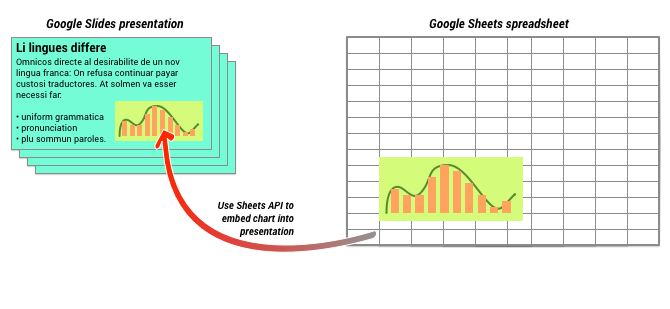Esta página descreve como adicionar gráficos das Planilhas Google às apresentações das Apresentações Google.
Adicionar gráficos a uma apresentação pode ajudar a criar mais impacto e tornar os dados mais significativos para o público. Os gráficos são ferramentas exclusivas e poderosas para mostrar padrões ou tendências em um conjunto de dados e podem ajudar a comunicar de forma clara dados quantitativos.
O vídeo acima mostra como gerar slides com dados de planilhas. Ele inclui um exemplo completo (Python) que adiciona um gráfico a um slide e também importa dados de células de planilha para uma tabela.
Sobre a adição de gráficos
Sempre que você apresentar informações quantitativas, os gráficos de dados podem melhorar sua apresentação. A API Slides permite incluir qualquer gráfico que você possa criar nas Planilhas Google: gráficos de barras, de linhas, de setores e muito mais.

Conforme mostrado no diagrama acima, primeiro você precisa criar o gráfico nas Planilhas Google. Depois que o gráfico for criado, você poderá incorporá-lo à sua apresentação.
O processo geral para gerenciar gráficos na sua apresentação é o seguinte:
- Crie um gráfico nas Planilhas Google.
- Use a API Sheets para ler o ID do gráfico EmbeddedChart resultante.
- Use CreateSheetsChartRequest uma vez para adicionar a um slide.
- Use RefreshSheetsChartRequest conforme necessário para sincronizar com os dados de origem.
Gráficos estáticos x vinculados
Quando você usa a API para adicionar um gráfico à sua apresentação, um dos parâmetros que você especifica é o LinkingMode. Isso determina se o gráfico é adicionado como uma imagem estática ou como um objeto que pode ser atualizado no futuro.
Use o modo LINKED se:
- Você quer atualizar o gráfico no futuro, refletindo as mudanças nos dados subjacentes.
- Você quer que os colaboradores tenham um link para a planilha que contém o gráfico de origem.
Use o modo NOT_LINKED_IMAGE (estático) se:
- Você quer que o gráfico nunca mude no futuro.
- Você não quer que os colaboradores tenham acesso a um link para a planilha de origem.
Escopos para acessar as Planilhas Google
Quando você adiciona um gráfico ao seu slide, a API Slides precisa acessá-lo nas Planilhas Google. Isso significa que sua solicitação precisa usar um dos seguintes escopos:
https://www.googleapis.com/auth/spreadsheets.readonly(recomendável)https://www.googleapis.com/auth/spreadsheetshttps://www.googleapis.com/auth/drive.readonlyhttps://www.googleapis.com/auth/drive
O escopo spreadsheets.readonly geralmente é o melhor para usar, porque é
o mais restritivo. No entanto, se o app já usa um dos outros escopos
listados acima, use esse escopo.
Como adicionar um gráfico
Para adicionar um gráfico, você precisa saber o ID da planilha e do gráfico nas Planilhas Google. Em seguida, chame o método batchUpdate, usando o
CreateSheetsChartRequest
uma vez para adicionar o gráfico.
O exemplo a seguir pega um gráfico e o adiciona a um slide como LINKED para
que possa ser atualizado mais tarde.
Como atualizar um gráfico
Se você incorporou um gráfico LINKED na apresentação, é possível atualizá-lo
a qualquer momento usando
RefreshSheetsChartRequest.
Isso atualiza o gráfico para sincronizar com o gráfico das Planilhas e
os dados em que ele se baseia.
O exemplo a seguir atualiza um gráfico existente:
